The noun phrases have a significant role in the expression of meaning in the advanced writing. For this purpose, these constructions require multiple number of elements known as head noun post-modifiers. These post-modifying elements (as complements) provide essential information for idea completion or (supplements) additional information to enrich the idea represented. In this post, a fully detailed information about these post-modifying elements has been incorporated for the sustenance of the academic writers.
There are ten types of phrasal as well as clausal noun post-modifiers whose description has been provided in the following sections.
1. Prepositional Phrases
The nouns can be post-modified by prepositional phrases. However, the head noun does not license these prepositional phrases. These phrases supply supplementary (i.e., additional) details about the head noun. This fact is obvious in the constructions such as medicine for the patient, a wrestler in the arena, a college of physicians, etc.
2. Adjectives and Adjective Phrases
Adjectives can precede the head noun in a noun phrase. For example, in the phrase broad field, the head is field and the adjective (broad) pre-modifies it. However, an adjective may also stay after the head noun as in any means necessary. In this noun phrase the head noun is means and it is post-modified by adjective necessary. Some other examples of post-modifying adjectives are: something incredible, advocate general, the workers responsible, etc.
Sometime, an adjective possesses its own post-modifier. For example, people fond of new cars, the results most likely to come out, mountains beautiful in the extreme, etc. The adjectives in such constructions cannot be put before the noun head.
3. Adverbs and Adverb Phrases
An adverb or adverb phrase may stay before or after the head noun in a noun phrase. For example, in mostly complicated texts, mostly is an adverb and its role is that of pre-modifier of complicated texts. In the discussion above, the adverb above post-modifies the head noun discussion. It is not only an adverb as a word that modifies the head noun. An adverb phrase also can modify the head noun, e.g. the house near the mountain. In this construction, near the mountain is an adverb phrase and its role is the modification of the head noun house.
4. Reflexive Pronouns
Reflexive pronouns, e.g. itself, themselves, etc., can stay as post-modifiers of head noun in a noun phrase. For example, the pilots themselves, the action itself, etc.
5. Nouns as Post-modifiers
When two nouns stay together and either refer to or describe one thing, the preceding noun has the role of head noun. In this combination, the noun that follows frequently does the role of a post-modifier e.g., the doctor Shaheen and desk top, etc. When the second noun carries essential information, comma is not used and when the second noun carries additional (nonessential) information, comma is used. Such combinations are called “apposition”.
6. Appositive Noun Phrases
The appositive NPs post-modify nouns. The significance of the appositive NPs is that they can stand alone in place of the whole NP. For example, the founder of Pakistan Muhammad Ali Jinnah was a great leader, can be written as Muhammad Ali Jinnah was a great leader. Examples of the appositive NPs:
- my brother Aslam
- the rescue service 1122
- our teacher chairman research committee
In the examples given above, constructions in bold frame are appositive noun phrases.
7. Non-Appositive Noun Phrases
The non-appositive NPs are different from appositive NPs in the sense that they cannot replace the head noun. For example, a man my level is rarely available, cannot be written as my level is rarely available. Examples of the non-appositive NPs are:
- a room this size,
- my mentor Raheel,
- someone his own height, etc.
In the examples given above, constructions in bold frame are non-appositive noun phrases.
8. Relative Clauses as Post Modifiers
Relative clauses also do the role of head noun post-modifiers in noun phrases. The structure of these clauses can be indicated as: relative pronoun/adjective/adverb + subject + verb in an ordinary tense form.
Examples of adjective clause as relative clause:
- The players who played well were given awards.
- The book which he wrote last year contains significant information.
- The bus driver whose driving license was fake was arrested.
- The car that I purchased last year is not good.
Examples of adverb clause as relative clause:
- The day when she won a nobel prize was a great day for her.
- The village where they spent their childhood is floral.
- The reason why he did not appear in the examination is not yet known.
- The manner how they cleared and cleaned the house was wonderful.
It is important to note that a relative clause post-modifies a noun that usually occurs just before it. However, if the noun is also post-modified by a prepositional phrase, the relative clause stays after the prepositional modifier. For example:
- The person at the gate whom I welcomed is my university fellow.
- The lawn mower with two wheels that I left in the lawn is missing.
- The watercourse at the village side that supplies water to the village has been repaired fully.
At times, the relative clause (if it is non-essential for the meaning of the head noun) may be separated from the noun it is modifying by comma.
9. Finite Clauses as Post-head Modifiers
Finite clauses as post-head modifiers are all relative clauses. For example:
- the person who supported me
- the car by which he travelled
- the guidance that he provided me with
- the mountain climber I met at base camp
The constructions in the above examples in italics are relative clauses.
10. Non-Finite Clauses as Post-Modifiers
Non-finite clauses may be of three types: gerund-participial, past-participial, and infinitival. For example:
- technicians working on this project
- a house constructed by that mason
- the task for you to perform
Participles i.e., -ing, –ed, and irregular (seen, drawn, set, etc.) forms of verb mostly describe nouns in noun phrases. Many of these go after their noun. However, some of these stay before their nouns.
When participles stay after a noun, they can stay alone or may be followed by their own object, complement or adverbial. In other words, in addition to doing the role of post modifiers, participles can also play the role of verb. It means they can take their own objects, complements, or adverbials. For example:
- Technicians working in power supply area should be cautious.
In this example, working (a participle) is followed by in power supply area (an adverbial) and itself immediately follows the noun technicians. However, there may come another post-modifier between the noun and the participle. Even the modified noun and the modifying participle may be more distant. For example:
b. The technicians with relevant expertise working in power supply area are always reliable.
When the post-modifying participles are not remote from the head noun, these can be taken as abbreviated relative clauses, e.g., working means as who worked. Commonly, participles can be replaced by a relative clause. However, turning relative clauses to participles is not always possible.
10.1 Pre-posed participles vs postposed participles
It is important to note that some participles can stay before or after the head noun equally. For example, remainingcan stay before or after the noun, e.g., the remaining time or the time remaining, etc. However, some participles can stay either before or after the head noun. For example, working can stay after the head noun as in the people working in factories.
The – ing participle may not post-modify the head noun when the noun is the object of a certain verb. For example, this door scans customers entering in the bank. In this sentence, the object of the verb scans is only customers and not their activity of entering. In other words, entering is not staying here as the adjective of customers. If we see this sentence from another perspective, we can say that entering of customers in the bank is being scanned. The customers’ activity, i.e., entering in the bank is a noun like gerund. The examples of verbs after which the positioning of –ing participle as adjective is not possible are find, entail, see, etc.
10.2 Infinitive (to-verb)
There are three common noun phrase types that can take to-verb as a post-modifier.
10.2.1 Head noun as the receiver
In these constructions, nouns are object of the infinitive. For example, job to perform, matter to see, bread to eat, time to consume, etc. Despite this role of the noun, the verb is in active form and not in passive form. At places, however, the passive form of infinitive is possible. The passive form in such cases is required to avoid a double meaning or to express a special non-passive meaning. For example, many things are yet to be recovered.
10.2.2 Head noun as the actor
In certain noun phrases, the head nouns can be the subject of the infinitives (to-verbs) that follow them. Thus they are the performers of the action indicated by the infinitives, e.g., implements to plough, talks to entice, vehicles to transport, etc. The nouns of this category always take infinitive after them in active form.
10.2.3 Head noun either an actor or receiver
Some head nouns take an active or passive infinitive not because they are actors or receivers of the action as shown above. The presence of the infinitive is to specify with precision what the noun is referring to, e.g., a need to be achieved.
In sum, this post has fully described and illustrated head noun post-modifiers. These post-modifying elements stay at phrase level as well as clause level. The constructions at phrase level are prepositional phrase, adjective phrase, adverb phrase, reflexive pronoun, noun-noun sequence and appositive phrase. The clause level post-modifying constructions are relative clause and various types of non-finite clause. The information and mastery of these constructions is crucial in impactful academic writing.
Sources Consulted
Biber et al., 1999)
Huddleston and Pullum (2007)
Mutiara, R. (2019)

